Preferences
You can customize many of MuseScore's default behaviors via the menu: Edit→Preferences... (Mac: MuseScore→Preferences...).
The Preferences dialog has multiple tabs:

Reset All Preferences to Default will reset all preferences to the ones MuseScore had when you installed it.
Cancel will close the dialog without applying changes.
General
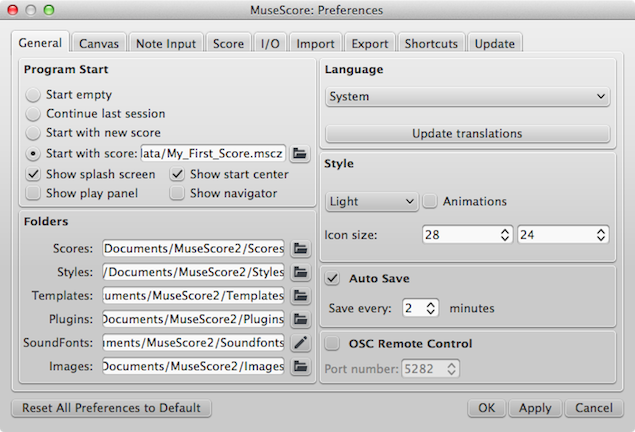
Here you can define:
- Program Start: Tick the boxes as appropriate to specify which score and what panels (Play Panel, Navigator, Start Center) you want to see when MuseScore opens.
- Folders: Specify the default folders for score files, style files, custom score templates, plugins, additional SoundFonts and images.
- Language: Chose the language used by the program. Translations may be updated from here too. Note that language translation updates can also be done via the menu: Help→Resource Manager.
- Theme / Style (prior to version 2.1): Specify a dark or light theme and the size of icons.
- Auto Save: How frequently the program autosaves.
- OSC Remote Control:
Canvas

Use Canvas to set your preferred color and wallpaper for the score background and paper. The default "Background" is grey (RGB 221, 221, 221; Alpha 221) and the default "Paper," white.
- Background: Use this to set the color or background around the score pages. Select "Color" then click on the bar to the right and make a choice from the color picker; or select "Wallpaper," click on the file icon and set a background image.
- Paper : Sets the color or background of the score pages. Controls identical to "Background" (above).
- Scroll Pages: This defines the way that the pages are layed out in the score. Chose "Horizontally" for a row layout, or "Vertically" for a column layout.
- Miscellaneous: "Draw antialiased" (the default option) makes diagonal lines and edges of shapes look smoother. "Proximity for selecting elements" controls the distance the mouse may be from an object and still act on it. Smaller numbers require more precision, making it harder to click on small objects. Larger numbers are less precise, making it harder not to click on nearby objects unintentionally. Choose a comfortable working value.
Note input
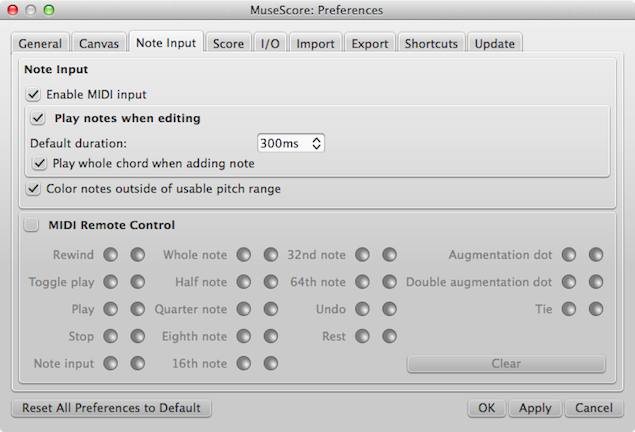
On this tab there are note input and MIDI remote control preferences. Here the following can be set:
Note Input
- Enable MIDI Input: Leave checked to allow MIDI input of notes.
- Color notes outside of usable pitch range: For details, see Coloring of notes outside an instrument's range and Usable pitch range (Staff properties: all staves).
- Delay between notes in automatic real-time mode (as of version 2.1): See Real-time (automatic).
- Play notes when editing: When ticked, MuseScore sounds the note when it is entered or selected. Tick "Play whole chord when adding note," if you want to hear all the notes of a chord when it is added to. You can also edit the "Default duration".
MIDI Remote Control
Midi Remote Control allows you to use certain keys on your MIDI keyboard to enter notes and rests and to select note durations, without involving the computer mouse or (computer) keyboard. The default setting is off.
To assign a command to a MIDI key:
- Ensure that "MIDI Remote Control" is checked (your MIDI keyboard should be connected befor opening the program).
- Click the red button next to the option you wish to assign a MIDI key to: the red button now lights up.
- Press a MIDI keyboard key. The red button becomes unlit and the green button lights up instead. The MIDI key has now been assigned to the desired option.
- Repeat "2" and "3" to assign other keys.
Once you have defined your key settings you can use the MIDI keyboard to control note input operations. You can verify your key settings by observing the MuseScore Note Input toolbar while pressing the MIDI keys.
To temporarily deactivate Midi Remote Control: uncheck "Midi Remote Control": all MIDI input key action buttons are now greyed out. Note: Your key assignments are always saved between MuseScore sessions and are not affected by deactivation.
Notes: (1) The "Clear" option turns off all the green buttons for the current MuseScore session but all the user-recorded MIDI key settings are retained and will be reloaded on the next session. (2) A MIDI key setting that is activated cannot afterwards be turned off, and the green button will always remain lit: however it can be overwritten with a different MIDI key by using the red button again. (3) If the same MIDI key is accidentally assigned to more than one option, then all the associated green buttons remain lit although only one will work. To fix, see "(2)".
Score
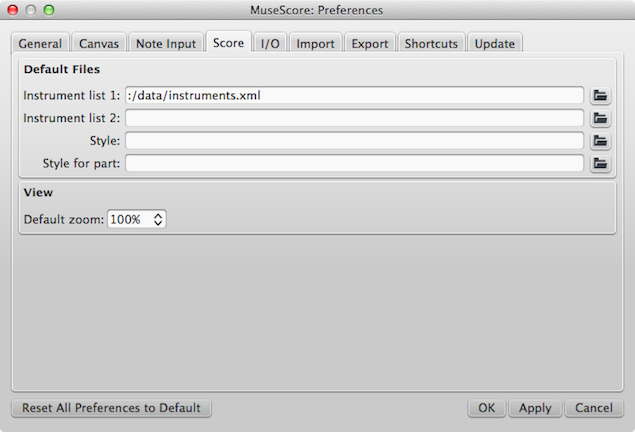
Score preferences include
- Default instrument list files (two may be selected)
- Default style for score and parts
- Default zoom
I/O
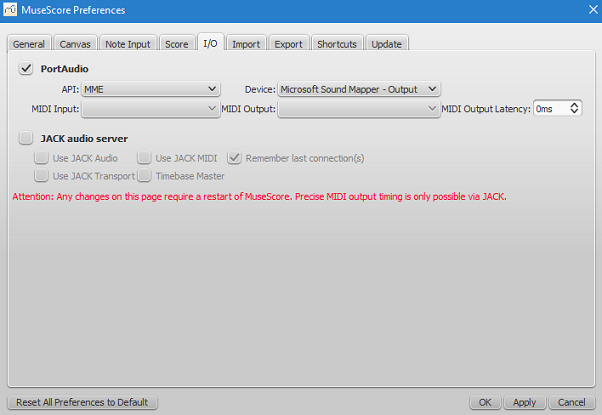
API / Device
This enables you to set the audio interface (API) and specify the device to be used for audio playback: e.g. built-in speakers/headphones, USB headset, wireless, etc.
MIDI Input/Output/Output Latency
When an external MIDI input device is connected, its identifier appears in MIDI Input. As of MuseScore 2.2, when the device is connected for the first time, you also need to select the correct MIDI Output option in order to enable note input and correct audio playback (e.g. in Windows, this might be "MMS<device name>"): then close and reopen the program to confirm the changes.
Versions of MuseScore prior to 2.2 only have the "MIDI Input" option. The correct MIDI output is automatically specified as long as the MIDI input device is connected correctly.
Jack Audio Server
Check these options as required if using the JACK Audio Connection Kit.
Import
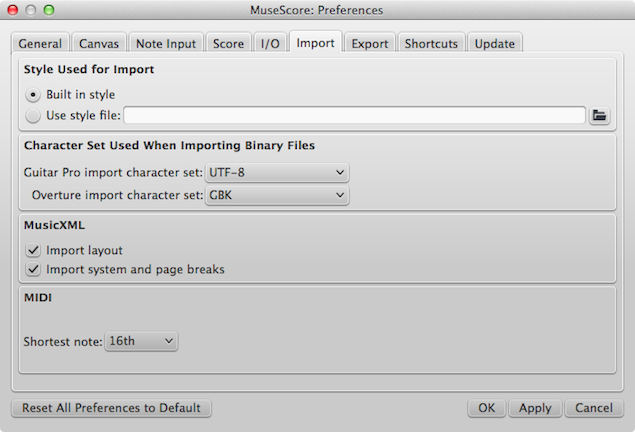
These settings determine how files from other sources are imported:
- Using either the built in MuseScore style or a style you choose
- Guitar Pro and Overture character sets
- MusicXML layout options
- Shortest note in MIDI files
Export
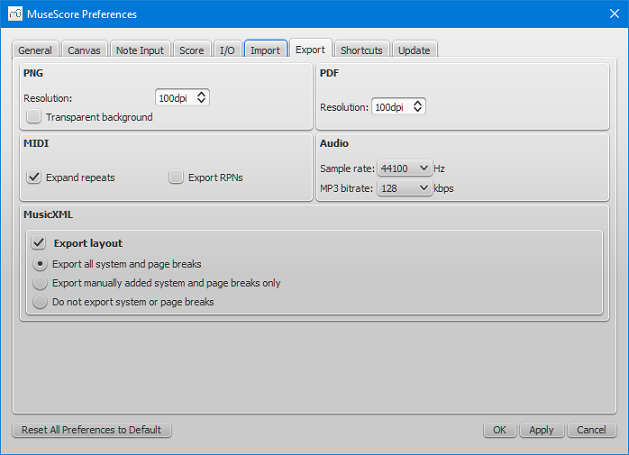
These settings determine how MuseScore files are exported:
- PNG/SVG image resolution (in DPI) and whether to use transparent background
- Whether to expand repeats in exported MIDI files
- Digital audio sample rate
- MP3 bitrate (as of MuseScore 2.1)
- Whether to export the layout and how to export system and page breaks to MusicXML
Shortcuts
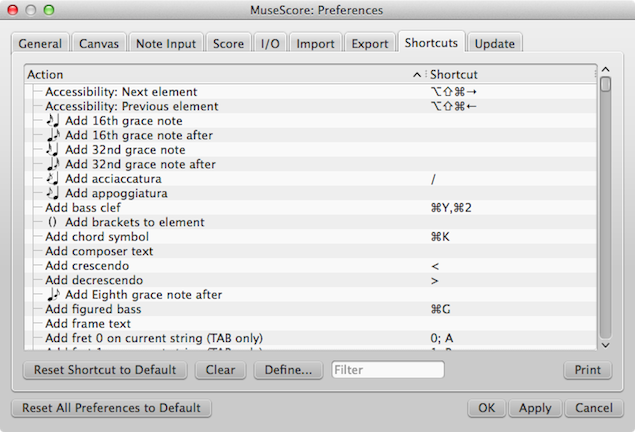
Every action possible with MuseScore is listed, with the associated shortcut if it exists. To define a new shortcut, select an existing entry in the list and click Define... (or just double click the entry), then enter the new shortcut using up to four keys. You can also reset any shortcut in the list to its default value, or clear a shortcut you select. Shortcuts listed in preferences appear next to their associated commands in the menus.
Note: Some shortcuts, including default ones, may not work with some keyboards.
The list of shortcuts can be printed out or exported to other media (pdf etc.) using the Print button in the bottom right of the window.
Update
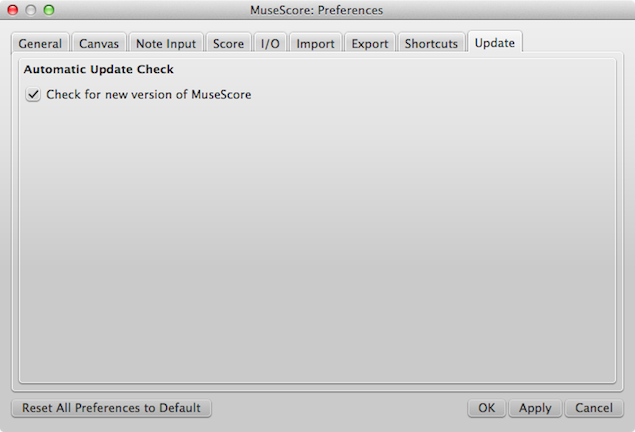
This sets whether MuseScore will check for updates at startup.
Updates may be checked manually in Help→Check for updates.